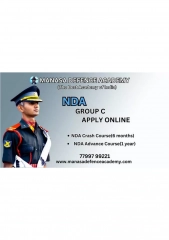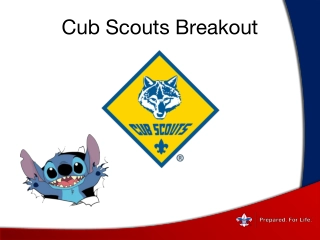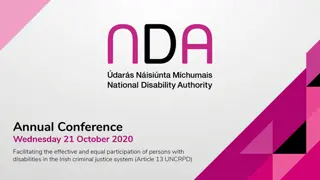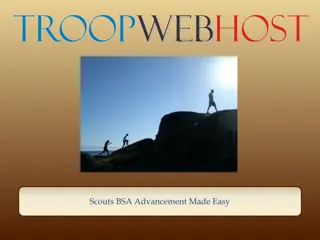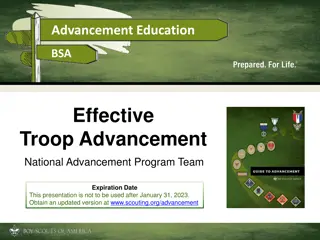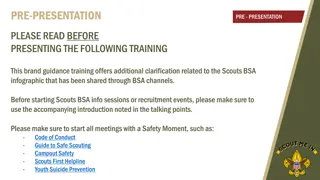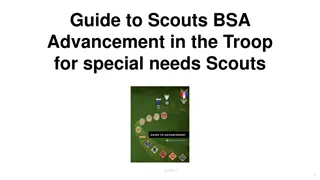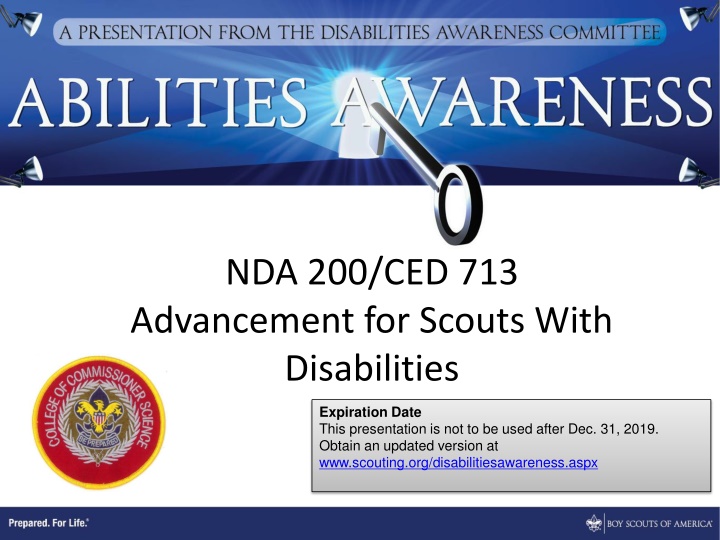
Advancement for Scouts With Disabilities - Importance and Process
Discover the significance of scouting for youth with disabilities and the process for documenting disabilities to qualify for alternative requirements or registration beyond the age of eligibility. Learn about the benefits of scouting in providing skills and social settings for youth with disabilities. Find out the steps involved in registration beyond the age of eligibility and the essential documentation required for approval.
Download Presentation

Please find below an Image/Link to download the presentation.
The content on the website is provided AS IS for your information and personal use only. It may not be sold, licensed, or shared on other websites without obtaining consent from the author. If you encounter any issues during the download, it is possible that the publisher has removed the file from their server.
You are allowed to download the files provided on this website for personal or commercial use, subject to the condition that they are used lawfully. All files are the property of their respective owners.
The content on the website is provided AS IS for your information and personal use only. It may not be sold, licensed, or shared on other websites without obtaining consent from the author.
E N D
Presentation Transcript
NDA 200/CED 713 Advancement for Scouts With Disabilities Expiration Date This presentation is not to be used after Dec. 31, 2019. Obtain an updated version at www.scouting.org/disabilitiesawareness.aspx
Why Scouting for Youth Who Have Disabilities? Scouting can have value for all eligible youth. Youth with disabilities often find challenges in social settings. Scouting teaches skills that help prepare them for life in our society. Scouting provides broader associations. 2
Documenting a Disability Required to qualify for alternative requirements or registration beyond the age of eligibility. Obtain letter from parent describing disability Provide youth application or membership card Complete BSA health form (parts A and C) Obtain statement from health professional Obtain letter from unit leader Provide other available supporting documentation, such as an IEP See Guide to Advancement, 10.1.0.2 3
Process Flow for Documenting a Disability Parents & leader describe disability Possible Individualized Education Plan (IEP) Medical Assessment (include BSA Health form) Documentation Understanding the Scout s strengths and limitations Doctor s certification Disability documented
Registration Beyond the Age of Eligibility Guide to Advancement, Topics 10.1.0.0 & 10.1.0.2 Disability must be documented as permanent and severe Arrangement is permanent; not an extension of time to earn a rank Process applies in all BSA programs from Cub Scouting through Venturing and Sea Scouts Council executive board must approve 5
Registration Beyond the Age of Eligibility No Use standard membership ages Does a qualifying disability exist? Yes Unit leader: Verifies disability Certifies chartered organization approval Provides documentation to council Follow steps under topic 10.1.0.2. If council approves, membership is coded.
Possible Criteria for Registration Beyond the Age of Eligibility Guide to Advancement, Topic 10.1.0.1 Emotional of behavioral disorder Physically disabled Traumatic brain injury Multiple coexisting disabilities Autism Spectrum Disorder Blind or sight-impaired Deaf of hard of hearing Cognitive disability Developmental delay Down Syndrome 7
What if a Scout is unable accomplish requirements as written? Alternative requirements are available. To Scouts registered beyond the age of eligibility. To Scouts with a permanent physical or mental disability, or a disability that is expected to last two or more years or beyond the 18th birthday. Alternative requirements procedures are specific to each Scouting program.
Cub Scout Advancement Guide to Advancement, Topic 10.2.1.0 The standard is Do Your Best. Cubmasters and pack committees may jointly determine appropriate substitutions for youth unable to attempt a requirement. Parents can assist by providing input on their son s abilities and challenges.
Boy Scout Rank Advancement Guide to Advancement, Topic 10.2.2.0 Rank requirements are to be completed as written, no more and no less. Scout, Tenderfoot, Second Class, and First Class can be modified via a request for approval from the council advancement committee. (Guide to Advancement, Topics 10.2.2.1 and 10.2.2.2). Venturers and Sea Scouts working on Boy Scout advancement.
Alternative Rank Requirements No Does disability exist? Use standard requirements Yes Document the disability Craft alternative requirements Submit request to district and council advancement committees No Committee evaluations Explanation to unit Yes Authorize alternative requirement(s) Notify unit
Alternative Merit Badges Guide to Advancement, Topic 10.2.2.3 Merit badge requirements mustnot be modified, but it is permitted to substitute one entire badge for another. Substitute must be as challenging. Application for Alternative Eagle Scout Rank Merit Badges, No. 512-730, is required. All required merit badges achievable by the Scout must be completed before applying.
Boards of Review Guide to Advancement, Topic 10.2.2.0 Some responsible flexibility is allowed if a Scout s disabilities could affect the outcome of a board of review. Inform board of review members ahead of time about the special circumstances. Be sure the unit leader is able to attend. Allow the parents or guardians to attend and assist with interpretation and insight.
Issues You May Encounter Decision on regular unit or special unit. Unhelpful parents Overprotective parents and parents who do not disclose a disability Behavior of others toward members with disabilities Activities that do not allow participation Administration of medications 14
Individual Scout Achievement Plan What is an ISAP? Like an IEP, but specific for Scouting A roadmap for parents A contract that can be followed and updated A guide for district and council decision makers 15
Resources Parents, guardians, and teachers Unit leadership The person who is disabled www.scouting.org/specialneeds.aspx Guide to Working with Scouts with Special Needs and Disabilities, No. 510-071 Scouting for Youth with Disabilities, No. 34059 Guide To Advancement , No. 33088 Individualized Scouting Achievement Plan (ISAP) 16
SCENARIO 1 A Scout permanently uses a wheelchair. He needs to hike and wants to join his troop for a day hike. Is it considered hiking if he is in his wheelchair? Why or why not?
SCENARIO 1 Yes, if this is the Scout s normal mode of transportation.
SCENARIO 2 A Scout is well on the way to Eagle. The Scout is planning on finishing by the time the Scout is 17 but at 17 is in an automobile accident. The Scout is in the hospital and then rehab for six months and cannot participate in Scouts. Might the Scout qualify for an extension of time for Eagle rank?
SCENARIO 2 Yes. Although this may not be a permanent situation, he was on track and should not be denied Eagle due to an incident beyond his control.
SCENARIO 3 A Scout is 17 and realizes there will be enough time to finish Eagle. The Scout has a learning disability and applies for an extension in time. Should this be approved? Why or why not?
SCENARIO 3 Maybe. Known circumstances such as a moderate learning disability that a Scout has coped with over many years, would not normally qualify for an extension. If a disability is not permanent and severe, and does not qualify for registration beyond the age of eligibility, then an extension is possible if the disability is so significant that advancement within the time frame allowed is essentially precluded.
SCENARIO 4 A blind Scout reports completing Astronomy merit badge. You ask the Scout how the youth identified constellations. The Scout replies that the merit badge counselor punched holes in paper plates, held them over the Scout s head outside at night, in the right place for the night sky, and the Scout felt the holes in the plates to identify the constellations. Should this be acceptable? Why or why not?
SCENARIO 4 Yes. The Scout completed the requirement with a reasonable level of assistance.
SUMMARY disabilities = different abilities We all have them. Youth who have disabilities want the same personal growth opportunities that any youth does. It is our challenge to provide them.
For More Information Guide to Advancement, No. 33088 Guide to Working with Scouts with Special Needs and Disabilities, No. 510-071 Scouting with Youth with Disabilities Manual, No. 34059 Application for Alternative Eagle Scout Rank Merit Badges, No. 512-730 Individual Scout Achievement Plan (ISAP) Request for Registration beyond the Age of Eligibility Other advancement resources available at: www.scouting.org/advancement

